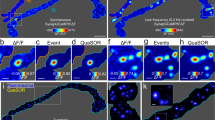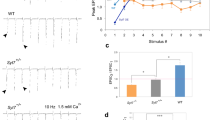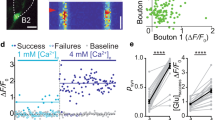Abstract
Synaptic transmission from a neuron to its target cells occurs via neurotransmitter release from dozens to thousands of presynaptic release sites whose strength and plasticity can vary considerably. We report an in vivo imaging method that monitors real-time synaptic transmission simultaneously at many release sites with quantal resolution. We applied this method to the model glutamatergic system of the Drosophila melanogaster larval neuromuscular junction. We find that, under basal conditions, about half of release sites have a very low release probability, but these are interspersed with sites with as much as a 50-fold higher probability. Paired-pulse stimulation depresses high-probability sites, facilitates low-probability sites, and recruits previously silent sites. Mutation of the small GTPase Rab3 substantially increases release probability but still leaves about half of the sites silent. Our findings suggest that basal synaptic strength and short-term plasticity are regulated at the level of release probability at individual sites.
This is a preview of subscription content, access via your institution
Access options
Subscribe to this journal
Receive 12 print issues and online access
$209.00 per year
only $17.42 per issue
Buy this article
- Purchase on Springer Link
- Instant access to full article PDF
Prices may be subject to local taxes which are calculated during checkout








Similar content being viewed by others
References
Atwood, H.L. & Karunanithi, S. Diversification of synaptic strength: presynaptic elements. Nat. Rev. Neurosci. 3, 497–516 (2002).
Pelkey, K.A. & McBain, C.J. Differential regulation at functionally divergent release sites along a common axon. Curr. Opin. Neurobiol. 17, 366–373 (2007).
Branco, T. & Staras, K. The probability of neurotransmitter release: variability and feedback control at single synapses. Nat. Rev. Neurosci. 10, 373–383 (2009).
Redman, S. & Walmsley, B. Amplitude fluctuations in synaptic potentials evoked in cat spinal motoneurones at identified group Ia synapses. J. Physiol. (Lond.) 343, 135–145 (1983).
Rosenmund, C., Clements, J.D. & Westbrook, G.L. Nonuniform probability of glutamate release at a hippocampal synapse. Science 262, 754–757 (1993).
Hessler, N.A., Shirke, A.M. & Malinow, R. The probability of transmitter release at a mammalian central synapse. Nature 366, 569–572 (1993).
Allen, C. & Stevens, C.F. An evaluation of causes for unreliability of synaptic transmission. Proc. Natl. Acad. Sci. USA 91, 10380–10383 (1994).
Betz, W.J. & Bewick, G.S. Optical analysis of synaptic vesicle recycling at the frog neuromuscular junction. Science 255, 200–203 (1992).
Ryan, T.A. & Smith, S.J. Vesicle pool mobilization during action potential firing at hippocampal synapses. Neuron 14, 983–989 (1995).
Murthy, V.N., Sejnowski, T.J. & Stevens, C.F. Heterogeneous release properties of visualized individual hippocampal synapses. Neuron 18, 599–612 (1997).
Ryan, T.A. Presynaptic imaging techniques. Curr. Opin. Neurobiol. 11, 544–549 (2001).
Murphy, T.H., Baraban, J.M., Wier, W.G. & Blatter, L.A. Visualization of quantal synaptic transmission by dendritic calcium imaging. Science 263, 529–532 (1994).
Oertner, T.G., Sabatini, B.L., Nimchinsky, E.A. & Svoboda, K. Facilitation at single synapses probed with optical quantal analysis. Nat. Neurosci. 5, 657–664 (2002).
Koester, H.J. & Johnston, D. Target cell-dependent normalization of transmitter release at neocortical synapses. Science 308, 863–866 (2005).
Budnik, V. & Ruiz-Cañada, C. The Fly Neuromuscular Junction: Structure and Function 2nd edn. (Elsevier Academic Press, San Diego, 2006).
Schuster, C.M., Davis, G.W., Fetter, R.D. & Goodman, C.S. Genetic dissection of structural and functional components of synaptic plasticity. I. Fasciclin II controls synaptic stabilization and growth. Neuron 17, 641–654 (1996).
Atwood, H.L., Govind, C.K. & Wu, C.F. Differential ultrastructure of synaptic terminals on ventral longitudinal abdominal muscles in Drosophila larvae. J. Neurobiol. 24, 1008–1024 (1993).
Geppert, M. & Sudhof, T.C. RAB3 and synaptotagmin: the yin and yang of synaptic membrane fusion. Annu. Rev. Neurosci. 21, 75–95 (1998).
Sudhof, T.C. The synaptic vesicle cycle. Annu. Rev. Neurosci. 27, 509–547 (2004).
Schlüter, O.M., Schmitz, F., Jahn, R., Rosenmund, C. & Sudhof, T.C. A complete genetic analysis of neuronal Rab3 function. J. Neurosci. 24, 6629–6637 (2004).
Schlüter, O.M., Basu, J., Sudhof, T.C. & Rosenmund, C. Rab3 superprimes synaptic vesicles for release: implications for short-term synaptic plasticity. J. Neurosci. 26, 1239–1246 (2006).
Kittel, R.J. et al. Bruchpilot promotes active zone assembly, Ca2+ channel clustering, and vesicle release. Science 312, 1051–1054 (2006).
Graf, E.R., Daniels, R.W., Burgess, R.W., Schwarz, T.L. & DiAntonio, A. Rab3 dynamically controls protein composition at active zones. Neuron 64, 663–677 (2009).
Tallini, Y.N. et al. Imaging cellular signals in the heart in vivo: Cardiac expression of the high-signal Ca2+ indicator GCaMP2. Proc. Natl. Acad. Sci. USA 103, 4753–4758 (2006).
Hendel, T. et al. Fluorescence changes of genetic calcium indicators and OGB-1 correlated with neural activity and calcium in vivo and in vitro. J. Neurosci. 28, 7399–7411 (2008).
Guerrero, G. et al. Heterogeneity in synaptic transmission along a Drosophila larval motor axon. Nat. Neurosci. 8, 1188–1196 (2005).
Miyawaki, A. et al. Fluorescent indicators for Ca2+ based on green fluorescent proteins and calmodulin. Nature 388, 882–887 (1997).
Hoang, B. & Chiba, A. Single-cell analysis of Drosophila larval neuromuscular synapses. Dev. Biol. 229, 55–70 (2001).
Fouquet, W. et al. Maturation of active zone assembly by Drosophila Bruchpilot. J. Cell Biol. 186, 129–145 (2009).
Lnenicka, G.A., Grizzaffi, J., Lee, B. & Rumpal, N. Ca2+ dynamics along identified synaptic terminals in Drosophila larvae. J. Neurosci. 26, 12283–12293 (2006).
Zucker, R.S. & Regehr, W.G. Short-term synaptic plasticity. Annu. Rev. Physiol. 64, 355–405 (2002).
Quigley, P.A., Msghina, M., Govind, C.K. & Atwood, H.L. Visible evidence for differences in synaptic effectiveness with activity-dependent vesicular uptake and release of FM1–43. J. Neurophysiol. 81, 356–370 (1999).
Lnenicka, G.A. & Keshishian, H. Identified motor terminals in Drosophila larvae show distinct differences in morphology and physiology. J. Neurobiol. 43, 186–197 (2000).
Stevens, C.F. & Wang, Y. Facilitation and depression at single central synapses. Neuron 14, 795–802 (1995).
Hanse, E. & Gustafsson, B. Quantal variability at glutamatergic synapses in area CA1 of the rat neonatal hippocampus. J. Physiol. (Lond.) 531, 467–480 (2001).
Marrus, S.B. & DiAntonio, A. Preferential localization of glutamate receptors opposite sites of high presynaptic release. Curr. Biol. 14, 924–931 (2004).
Branco, T., Staras, K., Darcy, K.J. & Goda, Y. Local dendritic activity sets release probability at hippocampal synapses. Neuron 59, 475–485 (2008).
Prange, O. & Murphy, T.H. Correlation of miniature synaptic activity and evoked release probability in cultures of cortical neurons. J. Neurosci. 19, 6427–6438 (1999).
Harris, K.M. & Stevens, J.K. Dendritic spines of CA1 pyramidal cells in the rat hippocampus: serial electron microscopy with reference to their biophysical characteristics. J. Neurosci. 9, 2982–2997 (1989).
Murthy, V.N., Schikorski, T., Stevens, C.F. & Zhu, Y. Inactivity produces increases in neurotransmitter release and synapse size. Neuron 32, 673–682 (2001).
Atwood, H.L. & Wojtowicz, J.M. Silent synapses in neural plasticity: current evidence. Learn. Mem. 6, 542–571 (1999).
Davis, G.W., DiAntonio, A., Petersen, S.A. & Goodman, C.S. Postsynaptic PKA controls quantal size and reveals a retrograde signal that regulates presynaptic transmitter release in Drosophila. Neuron 20, 305–315 (1998).
Anderson, J.C. et al. Modular organization of adaptive colouration in flounder and cuttlefish revealed by independent component analysis. Network 14, 321–333 (2003).
Acknowledgements
We thank R.S. Zucker for helpful discussions, G. Kauwe and G. Agarwal for help generating the SynapGCaMP2 fly line, H.L. Aaron for advice on imaging and J.A. Min for help with testing fly strains. We also thank A. DiAntonio for gifts of fly strains and for the Rab3 antibody. This work was supported by US National Science Foundation grant FIBR 0623527.
Author information
Authors and Affiliations
Contributions
E.S.P. carried out experiments and data analysis. E.Y.I. supervised the project. E.S.P. and E.Y.I. wrote the manuscript.
Corresponding author
Ethics declarations
Competing interests
The authors declare no competing financial interests.
Supplementary information
Supplementary Text and Figures
Supplementary Figures 1–9, Supplementary Table 1 and Supplementary Text (PDF 638 kb)
Supplementary Movie 1
Single action-potential evoked responses in the NMJ of Fig. 1. (MOV 71 kb)
Supplementary Movie 2
Spontaneous activity in the NMJ of Fig. 2. (MOV 547 kb)
Supplementary Movie 3
Responses to paired-pulse stimulation (NMJ of Fig. 7). (MOV 155 kb)
Rights and permissions
About this article
Cite this article
Peled, E., Isacoff, E. Optical quantal analysis of synaptic transmission in wild-type and rab3-mutant Drosophila motor axons. Nat Neurosci 14, 519–526 (2011). https://doi.org/10.1038/nn.2767
Received:
Accepted:
Published:
Issue Date:
DOI: https://doi.org/10.1038/nn.2767
This article is cited by
-
Determinants of synapse diversity revealed by super-resolution quantal transmission and active zone imaging
Nature Communications (2022)
-
Function of Drosophila Synaptotagmins in membrane trafficking at synapses
Cellular and Molecular Life Sciences (2021)
-
Autophagy within the mushroom body protects from synapse aging in a non-cell autonomous manner
Nature Communications (2019)
-
Rapid active zone remodeling consolidates presynaptic potentiation
Nature Communications (2019)
-
Presynaptic spinophilin tunes neurexin signalling to control active zone architecture and function
Nature Communications (2015)



